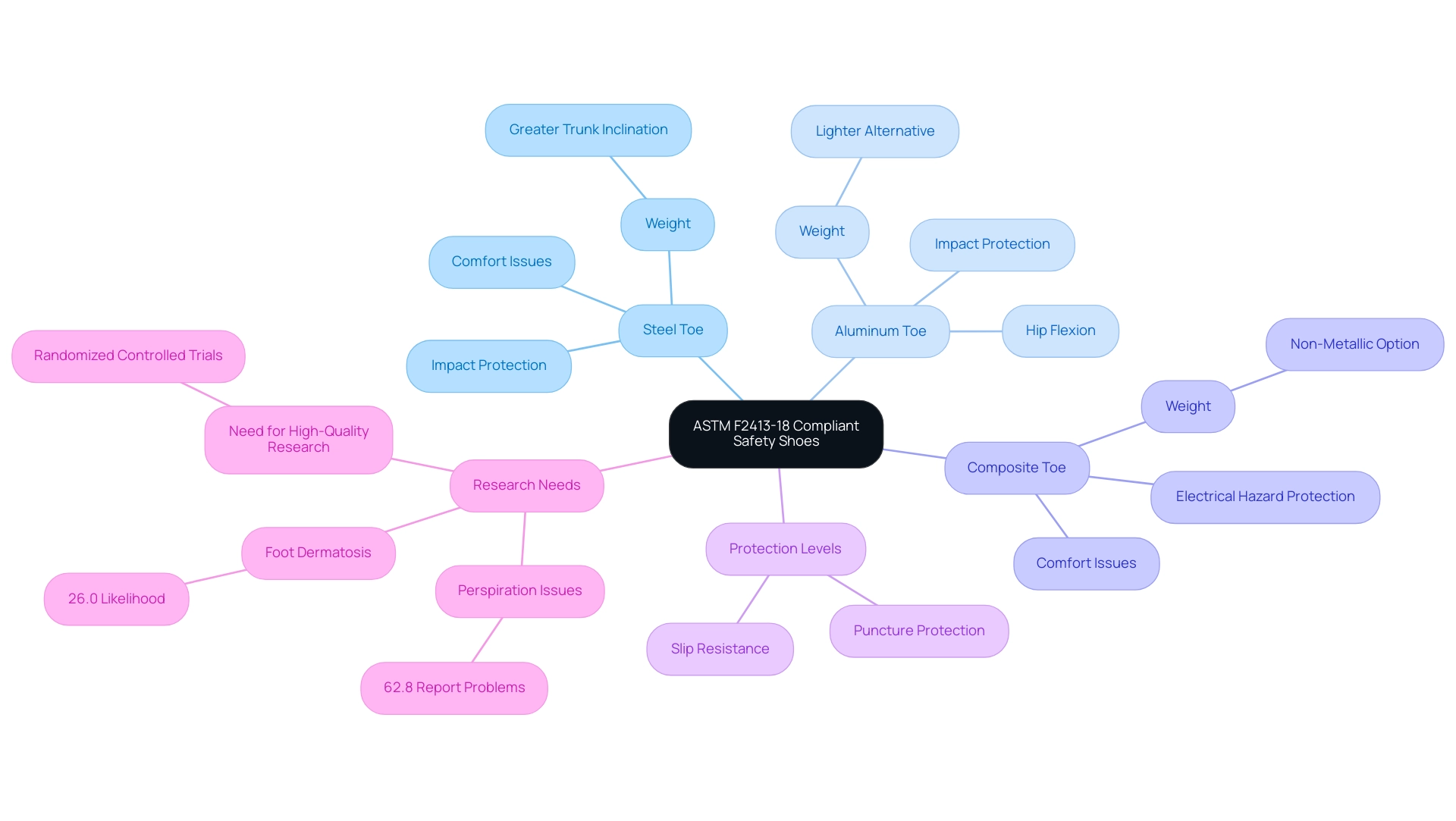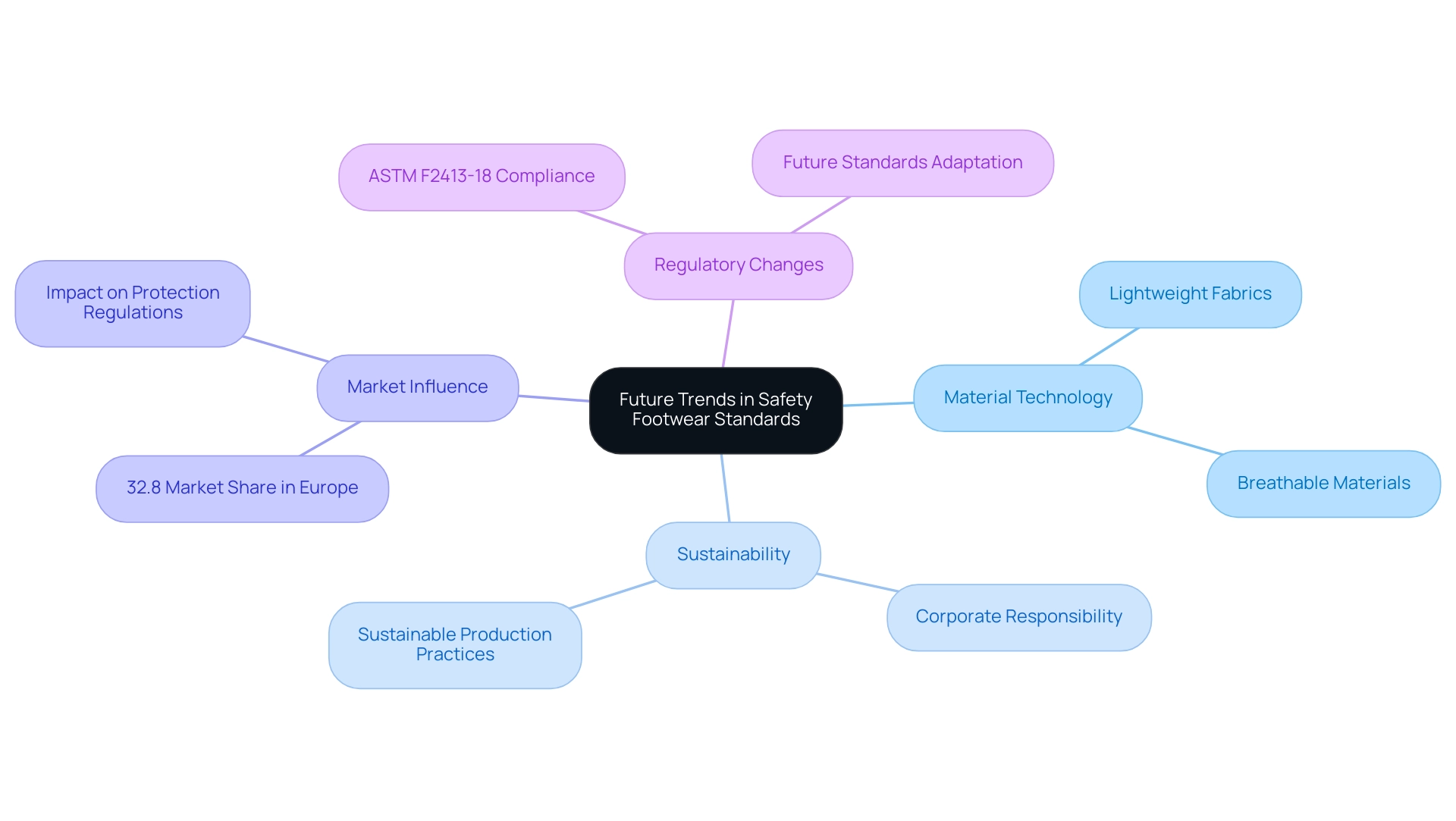Understanding ASTM F2413-18 Safety Shoes: A Complete Tutorial for Safety Compliance
Explore ASTM F2413-18 safety shoes to ensure compliance and enhance workplace safety.

Overview:
The ASTM F2413-18 standard for safety shoes is essential for ensuring employee protection against various workplace hazards, including impact and puncture risks. The article emphasizes that compliance with this standard not only mitigates injury risks, as evidenced by statistics showing a significant prevalence of work-related foot dermatosis among workers, but also helps employers avoid legal repercussions and fosters a culture of safety within the organization.
Key Highlights:
- ASTM F2413-18 outlines performance criteria for safety shoes to protect against impact, compression, and puncture hazards.
- Compliance with the standard is essential for employee safety, with statistics showing 26% of workers experience work-related foot dermatosis.
- Safety shoes come with three toe protection types: steel (highest protection), aluminum (lighter option), and composite (non-metallic for electrical hazards).
- Proper fit, lightweight materials, and breathability are crucial for comfort and compliance in safety footwear.
- Non-compliance with ASTM F2413-18 can lead to severe injuries and legal repercussions for employers.
- Future trends in safety footwear may include advanced materials, sustainability, and adherence to evolving regulations.
- Engaging with industry experts and safety forums is vital for brands to stay updated on compliance and market trends.
Introduction
In the ever-evolving landscape of workplace safety, the ASTM F2413-18 standard stands as a pivotal guideline for the selection of protective footwear. Established by the American Society for Testing and Materials, this standard outlines essential performance requirements that safety shoes must meet to effectively guard against a range of occupational hazards, including impacts, compression, and punctures.
As industries face increasing scrutiny over worker safety, understanding this standard becomes paramount for employers aiming to mitigate risks and enhance the well-being of their workforce. With alarming statistics highlighting the prevalence of work-related foot conditions, the implications of non-compliance extend beyond regulatory obligations to encompass employee health and organizational integrity.
This article delves into the intricacies of ASTM F2413-18, exploring its key features, the importance of compliance, and future trends that promise to shape the safety footwear landscape.
Overview of ASTM F2413-18: Understanding the Standard for Safety Footwear
The ASTM F2413-18 safety shoes guideline, created by the American Society for Testing and Materials, outlines the performance criteria for safety shoes designed to guard workers against various occupational dangers such as impact, compression, and puncture threats. This extensive standard classifies protective shoes based on their safety characteristics, allowing employers to choose the most appropriate shoes according to the particular hazards present in their work settings. With the average mass of underground coal miners being 92.8 kg, the physical demands placed on safety shoes in such industries are significant.
Compliance with ASTM F2413-18 safety shoes is not merely a regulatory obligation; it is a critical component in safeguarding employees against potential injuries. Recent statistics indicate that 26% of workers are likely to experience work-related foot dermatosis, with foot eczema being the most common condition, highlighting the health risks associated with insufficient shoes. This highlights the importance of following these guidelines, such as wearing ASTM F2413-18 safety shoes, to improve employee protection across different sectors.
Additionally, a review named 'Research Gaps in Occupational Footwear Studies' has highlighted the necessity for continuous investigation into how differences in footwear design, particularly in ASTM F2413-18 safety shoes, can affect protection and performance, relating back to the consequences of the ASTM specification. Comprehending the intricacies of this guideline is vital for employers aiming to foster a secure work environment and mitigate the risk of injury.

Key Features of ASTM F2413-18 Compliant Safety Shoes: Toe Types and Protection Levels
ASTM compliant footwear is available with three main types of toe protection: steel, aluminum, and composite materials. Steel toe shoes are renowned for offering the highest level of protection against severe impacts, making them an essential choice in heavy-duty environments. However, they may lead to greater trunk inclination during gait, which can affect overall comfort and body mechanics.
Aluminum toe choices offer a lighter substitute that still adheres to strict performance criteria, effectively balancing weight and protection, while also having a different effect on hip flexion compared to steel alternatives. For individuals operating in electrically hazardous settings, composite toe footwear provides a non-metallic option that not only meets regulatory requirements but also delivers electrical hazard protection without the heaviness of steel.
The ASTM F2413-18 safety shoes standard further specifies various protection levels, addressing not just impact but also protecting against punctures, slips, and other workplace risks. This comprehensive strategy guarantees that employees are provided with shoes customized to their particular work environments, thereby improving overall security. Crucially, recent discoveries suggest that a notable proportion—62.8%—of individuals have reported problems associated with perspiration in work shoes, a factor that should be taken into account when choosing the suitable protective shoe.
As Brans R. observes, the risk of work-related foot dermatosis is a real concern, with studies indicating it may impact about 26.0% of employees.
Moreover, the case study named 'Need for Further Research on Protective Shoes' emphasizes the shortcomings of current research on protective shoes, including subpar quality and absence of stringent methodologies. This highlights the urgent need for high-quality research to better understand the long-term effects of protective shoes on foot health and to develop effective interventions. Therefore, comprehending the distinctions in toe types and their associated advantages, along with the trade-offs—like weight in relation to protection—is essential for D2C brand owners seeking to offer effective and compliant solutions, such as ASTM F2413-18 safety shoes.

Choosing the Right Safety Shoes: Tips for Comfort and Compliance
When choosing protective footwear, it is crucial to prioritize factors such as fit, weight, and material composition. A snug fit is essential; however, shoes should not be excessively tight, as this can lead to discomfort during extended hours of work. Notably, a case study titled 'Impact of Footwear Comfort on Running Economy' revealed a direct link between comfort levels and performance outcomes, reinforcing the necessity of selecting shoes that cater to comfort alongside compliance.
Opting for lightweight materials is advisable, as heavy shoes are known to contribute to worker fatigue, ultimately impacting productivity and well-being. Breathable fabrics are also important, as they enhance overall comfort by regulating temperature and moisture. Furthermore, recent news emphasized that the slip-resistance performance of winter shoes with composite outsoles significantly declined after extensive use, indicating that material selections can have practical implications for protection over time.
Ensuring that the ASTM F2413-18 safety shoes adhere to regulations for protection and performance is essential. Trying on various styles and brands allows individuals to identify the best fit tailored to their specific needs. To further emphasize the importance of fit, Sandrey et al. noted that sex differences in foot dimensions have been reported among soccer players, which suggests that fit considerations should be tailored to different users. Footwear experts also recommend that brand owners consider the implications of comfort-related complaints, which can significantly affect workplace productivity and employee satisfaction.

The Importance of Compliance: Implications of ASTM F2413-18 in the Workplace
Adhering to the standards of ASTM F2413-18 safety shoes is not merely a regulatory formality; it is a crucial factor in safeguarding employees in potentially hazardous work environments. Non-compliance can result in severe injuries, with recent studies indicating that work-related foot dermatosis was present in 26% of cases, with foot eczema representing a significant 93.3% of these instances. This highlights the urgent need for suitable protective shoes, specifically ASTM F2413-18 safety shoes, as the consequences of ignoring these standards can lead to legal repercussions and significant financial penalties for employers.
As highlighted by experts, design characteristics of footwear—such as heel breadth, ball of foot girth, instep height, and toe angle—are intricately linked to various forms of discomfort and injury, including lower back, hip, ankle, and foot pain. Furthermore, promoting a setting where appropriate shoes are standard nurtures a culture of security and diligence within the organization. Regular audits and dedicated training on the necessity of wearing ASTM F2413-18 safety shoes compliance not only reinforce this commitment but also empower employees to execute their responsibilities without the added risk of injury.
The findings from a case study on emergency response times further illustrate the importance of proper shoe sizing, demonstrating that employees wearing appropriately sized clogs completed emergency tasks more efficiently. This emphasizes that adherence to ASTM F2413-18 safety shoes guidelines is not merely about fulfilling criteria, but also about improving operational efficiency and safeguarding employee well-being.

Future Trends in Safety Footwear Standards: What to Expect from ASTM F2413-18
As industries advance, protective shoe criteria such as ASTM F2413-18 safety shoes are expected to undergo considerable change. Future enhancements may focus on advanced materials technology, including the adoption of lightweight, breathable fabrics that enhance protection while ensuring comfort. Significantly, Europe represented a 32.8% portion of the worldwide industrial protective shoe market in 2023, emphasizing the region's impact on protection regulations and practices.
This shift will likely coincide with a stronger emphasis on sustainability in shoe production, aligning with corporate responsibility initiatives that are increasingly prioritized across sectors. As one industry expert noted, 'Sustainability is no longer an option but a necessity for brands looking to thrive in the future.' To stay competitive, brands must actively observe these trends, ensuring their protective shoes, such as ASTM F2413-18 safety shoes, not only meet current standards but are also ready for forthcoming regulatory changes.
Engaging with industry experts and participating in safety footwear forums will provide essential insights, helping brands stay ahead in this dynamic landscape. For example, recent case studies have shown how companies that innovate with sustainable materials have not only improved their compliance but also enhanced their market appeal.

Conclusion
Understanding and adhering to the ASTM F2413-18 standard is essential for ensuring workplace safety through proper footwear selection. This standard outlines critical performance requirements that safety shoes must meet to protect against various occupational hazards, including impacts, compression, and punctures. As highlighted, compliance is not merely a regulatory necessity but a fundamental aspect of safeguarding employee health and enhancing overall workplace integrity.
The article emphasizes the importance of choosing the right safety shoes tailored to specific work environments, considering factors such as:
- Toe protection types
- Comfort
- Material composition
With statistics indicating a significant prevalence of work-related foot conditions, the implications of neglecting these standards can lead to serious consequences for both employees and employers alike. Therefore, fostering a culture of compliance and prioritizing worker safety through appropriate footwear can lead to improved productivity and reduced injury rates.
Looking ahead, the evolution of safety footwear standards promises advancements in material technology and a growing emphasis on sustainability. As industries adapt to new challenges, staying informed and engaged with these trends will be crucial for brands aiming to meet and exceed compliance requirements. Ultimately, prioritizing ASTM F2413-18 standards not only protects employees but also positions organizations as leaders in workplace safety and responsibility.



